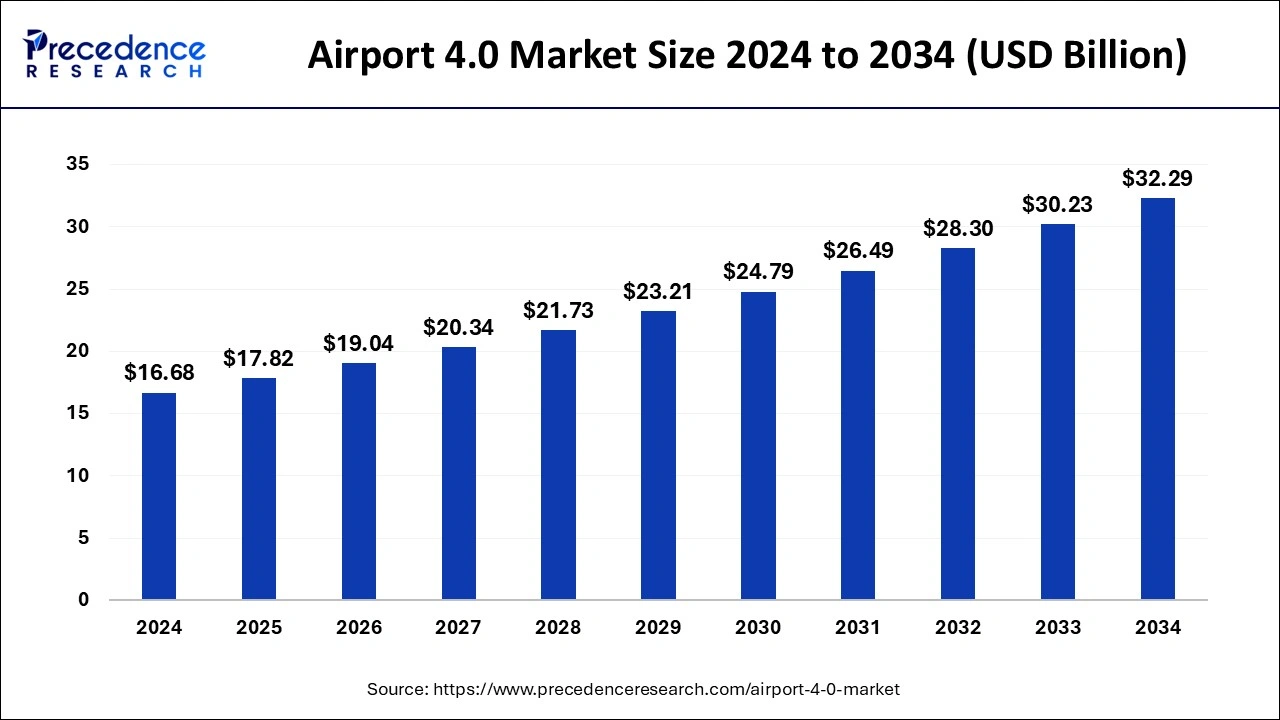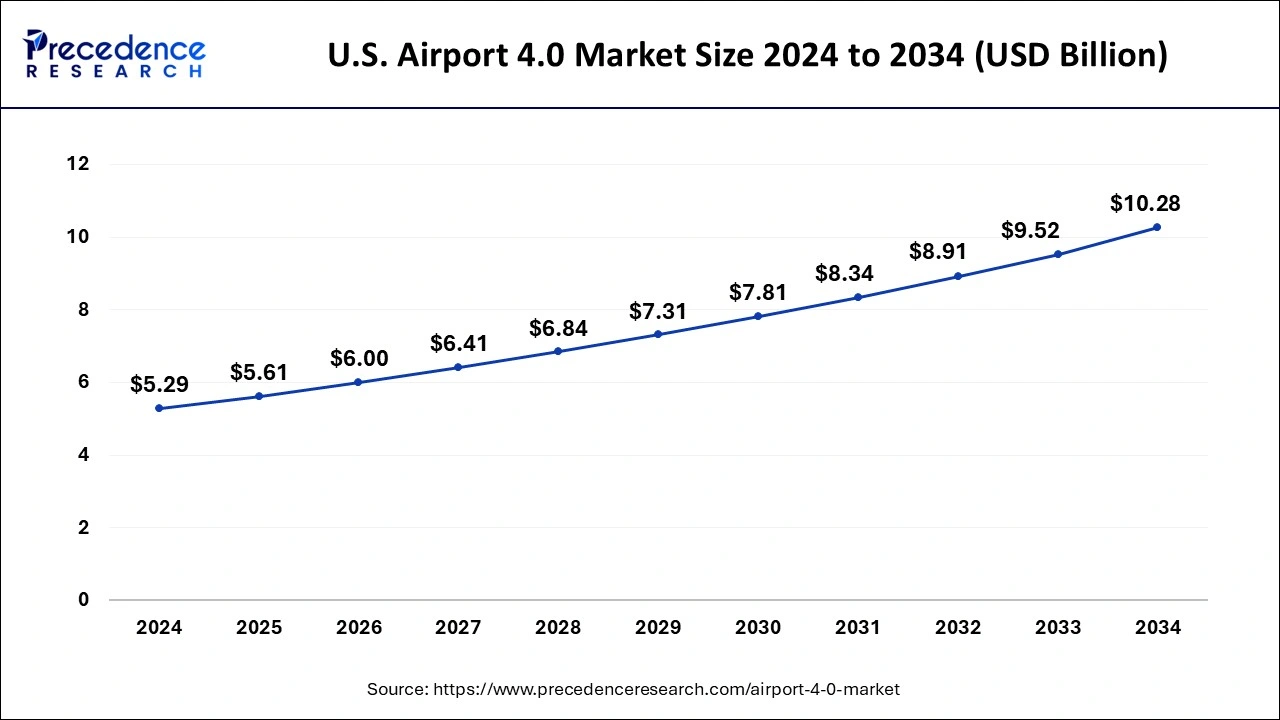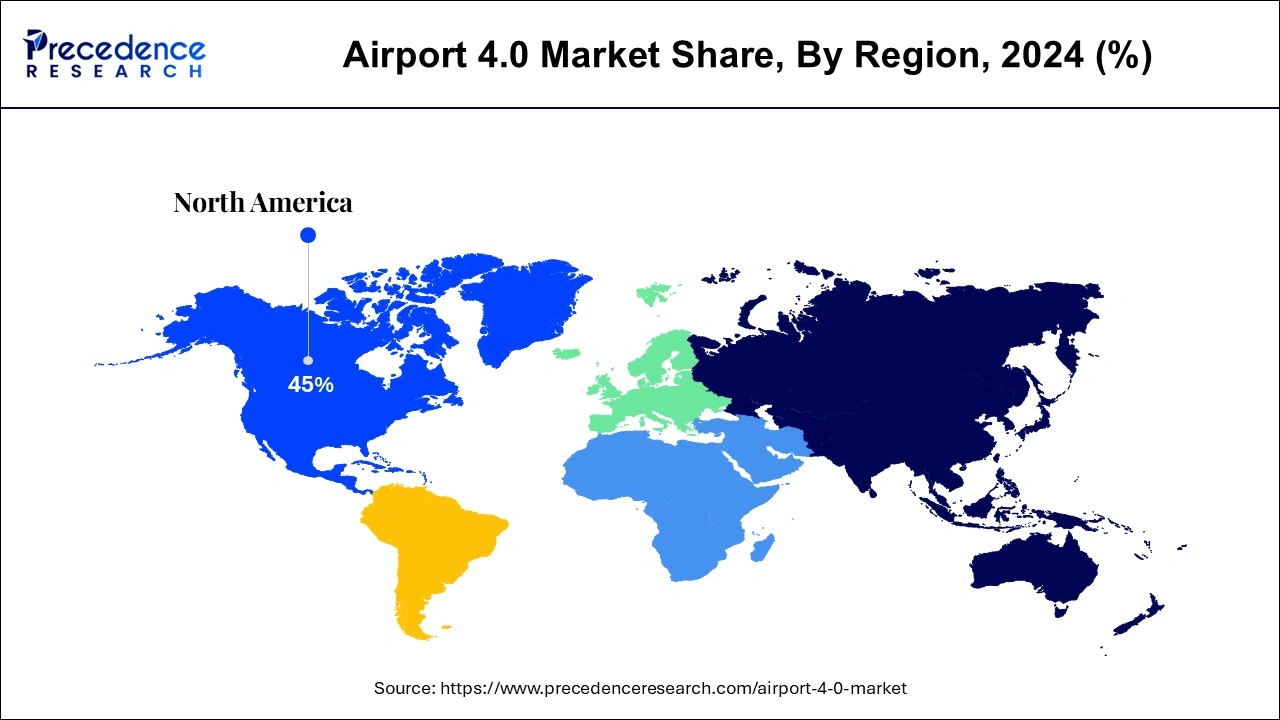List of Contents
Airport 4.0 Market Size and Growth 2025 to 2034
The global airport 4.0 market size was estimated at USD 16.68 billion in 2024 and is predicted to increase from USD 17.82 billion in 2025 to approximately USD 32.29 billion by 2034, expanding at a CAGR of 6.83% from 2025 to 2034. With the integration of IoT, AI, and big data analytics, airports are transforming into intelligent hubs with a rising inclination for passenger safety, and frictionless air traveling is a major key factor in driving the airport 4.0 market globally.

Airport 4.0 MarketKey Takeaways
- The global airport 4.0 market was valued at USD 16.68 billion in 2024.
- It is projected to reach USD 32.29 billion by 2034.
- The airport 4.0 market is expected to grow at a CAGR of 6.83% from 2025 to 2034.
- North America dominated the global market with the largest market share of 45% in 2024.
- Europe has been expecting the fastest growth in the global market.
- Asia Pacific holds a notable share of the global market.
- By end market, the upgrade and services segment dominated the market globally in 2024.
- By end market, the implementation segment is expected to experience notable growth in the forecast period.
- By application segment, the airside segment accounted for the largest market share in 2024.
- By application, the passenger screening segment is predicted to show rapid growth in the market.
- By size, the large airport segment dominated the market in 2024.
- By operation, in 2023, the non-aeronautical segment dominated the global market.
U.S. Airport 4.0Market Size and Growth 2025 to 2034
The U.S. airport 4.0 market size was evaluated at USD 5.29 billion in 2024 and is predicted to be worth around USD 10.28 billion by 2034, rising at a CAGR of 6.87% from 2025 to 2034.

North America held the highest market share of 45% in 2024. North America's airport 4.0 market is driven by robust growth, along with technological innovation, passenger expectations, and the need for efficient and sustainable airport operations. The major reason behind the thriving market is a strong emphasis on technological innovation, passenger-centric services, and operational efficiency across the region.
The United States leads the way in smart airport development, with major hubs like Hartsfield-Jackson Atlanta International Airport and Los Angeles International Airport investing heavily in advanced technologies. These investments include IoT sensors for real-time monitoring, AI-driven predictive analytics for maintenance, and biometric authentication systems for seamless passenger experiences.
Canada is also making significant efforts in airport 4.0 initiatives, with airports like Toronto Pearson International Airport implementing smart solutions to enhance efficiency and sustainability. These include renewable energy projects, digital passenger services, and data-driven operational improvements. As the region continues to invest in smart solutions, it remains at the forefront of airport modernization on a global scale.

Europe region for airport 4.0 have been expecting rapid growth owing to the huge investment for cultivating the existing airport and thus, it becomes fastest growing region in the global market. The region's airports are actively investing in advanced technologies such as IoT, AI, and big data analytics to streamline operations, optimize resource utilization, and improve overall passenger satisfaction.
The European airport 4.0 market market is experiencing significant growth and innovation. As a hub for air travel and home to some of the busiest airports in the world, Europe places a strong emphasis on enhancing operational efficiency, passenger experience, and sustainability. This includes initiatives like biometric authentication for seamless travel, predictive maintenance to minimize downtime, and AI-powered customer service for personalized experiences.
Moreover, Europe's commitment to environmental sustainability is driving the adoption of eco-friendly solutions within airports, such as renewable energy sources, energy-efficient infrastructure, and green transportation options. Overall, the European airport 4.0 market presents ample opportunities for growth; it is mainly driven by the region's dedication to technological advancement, passenger-centric services, and environmentally conscious decisions.
Countries like Germany and the UK, which boast some of the busiest airports in Europe, such as Frankfurt Airport and London Heathrow Airport, have a strong focus on implementing cutting-edge technologies to enhance operational efficiency and passenger experience. These countries have led the adoption of IoT, AI, and big data analytics for seamless travel experiences and optimized airport operations.
Scandinavian countries like Sweden and Denmark are also at the forefront of airport 4.0 development, leveraging their expertise in sustainable methods to integrate renewable energy sources and eco-friendly solutions within airport infrastructure. Meanwhile, countries in Southern Europe, such as Spain and Italy, are making strides in modernizing their airports to meet growing passenger demands, with a particular emphasis on digitalization and automation to improve overall efficiency.
Eastern European countries like Poland and Hungary are witnessing rapid growth in the development of airport 4.0 sector, driven by increasing air traffic and investments in infrastructure upgrades to accommodate advanced technologies. Also, the European airport 4.0 market showcases a dynamic landscape of innovation and collaboration, with each country contributing to the region's leadership in airport modernization and sustainability.
Asia Pacific holds a notable share of the market. This is attributed to the region's dense population with a technically growing airport 4.0 market. Asia Pacific is experiencing rapid expansion, fueled by the region's booming aviation sector and growing passenger volumes. It presents significant opportunities for smart airport growth, driven by a combination of technological innovation, increasing air travel demand, and the need for sustainable aviation solutions. As countries across the region continue to invest in technically sound airport infrastructure, Asia Pacific is poised to become a global leader in airport modernization and innovation.
China, with its massive population and rapidly expanding air travel market, leads the region in airport 4.0 development. Major airports like Beijing Capital International Airport and Shanghai International Airport are investing heavily in advanced technologies such as AI, IoT, and biometrics to improve operational efficiency and passenger experience.
Singapore stands out as a global leader in smart airport innovation, with Changi Airport being consistently ranked among the best airports in the world. Changi Airport's Jewel project, which features cutting-edge technologies like biometric immigration, automated check-ins, and indoor navigation systems, serves as a model for airport development worldwide.
- A recent list from Asia Stats shows 8th rank in the globe, which was acquired by Singapore's Changi Airport for its wi-fi connectivity.
Other countries in Asia Pacific, including India and Japan, are also investing in smart airport initiatives to meet growing passenger demands and enhance competitiveness. These initiatives range from digitalization and automation to sustainability-focused projects such as renewable energy integration and carbon footprint reduction.
- At a recently held summit at Global Aviation in Mumbai, the Civil Aviation Ministry's ‘Vision 2040' reported that there will be 190-200 functioning airports in India by 2040. Delhi and Mumbai will have three international airports each, while the top 31 Indian cities will have two operational airports each.
Market Overview
The airport 4.0 market is experiencing robust growth, driven by escalating demand for advanced technologies to enhance passenger experience and operational efficiency. With the integration of IoT, AI, and big data analytics, airports are transforming into intelligent hubs. Key trends include seamless biometric authentication, predictive maintenance, and AI-powered customer service. The airport 4.0 market is witnessing significant investments from both the public and private sectors to upgrade infrastructure and implement smart solutions. Rising air traffic, coupled with the need for sustainable practices, further propels market expansion. However, challenges such as cybersecurity threats and regulatory complexities persist, necessitating comprehensive strategies for sustainable growth.
Airport 4.0 MarketGrowth Factors
- Integration of IoT, AI, and big data analytics.
- Escalating demand for advanced technologies.
- Focus on enhancing passenger experience and operational efficiency.
- Increasing investments from the public and private sectors.
- Rising air traffic leads to greater adoption of smart solutions.
- Emphasis on sustainable practices driving market expansion.
- Implementation of seamless biometric authentication and predictive maintenance.
- AI-powered customer service enhancing overall airport operations.
- Opportunities for infrastructure upgrades to accommodate smart solutions.
- Technological advancements are driving innovation in the smart airport sector.
Market Scope
| Report Coverage | Details |
| Market Size in 2025 | USD 17.82 Billion |
| Market Size by 2034 | USD 32.29 Billion |
| Market Growth Rate from 2025 to 2034 | CAGR of 6.83% |
| Largest Market | North America |
| Base Year | 2024 |
| Forecast Period | 2025 to 2034 |
| Segments Covered | By End Market, By Application, By Size, and By Operation |
| Regions Covered | North America, Europe, Asia-Pacific, Latin America, and Middle East & Africa |
Market Dynamics
Driver
Enhanced passenger experiences
Technological advancements, including IoT, AI, and big data analytics, are revolutionizing airport operations by enabling real-time data analysis, predictive data analysis, and personalized passenger services. These innovations optimize airport resources, streamline processes, and improve optimum efficiency, which aids in cost savings and operational excellence. Simultaneously, the growing demand for enhanced passenger experiences is one of the leading reasons airports are driving to invest in smart solutions.
Passengers seek seamless travel experiences, from check-in to boarding, and expect personalized services tailored to their preferences. Such advanced airports benefit from technology to deliver frictionless journeys, offering features like biometric authentication, self-service, and real-time updates on flight status. By prioritizing passenger satisfaction, airports can gain a competitive edge and foster loyalty, propelling further growth of the airport 4.0 market globally.
Restraint
Cybersecurity concerns
A significant restraint for the airport 4.0 market is the potential cybersecurity vulnerabilities related to the integration of advanced technologies. As airports become increasingly reliant on interconnected systems and data-driven operations, they have become more susceptible to cyber threats such as hacking, data breaches, and malware attacks. These security risks are not only potential threats to passenger information and airport operations but also pose a challenge to national security.
Addressing cybersecurity concerns requires substantial investments in robust security measures, regular system updates along with proper employee training, and compliance with stringent regulatory standards with respective government authorities. Failure to adequately reduce the cybersecurity risks can result in financial losses, reputational damage, and disruptions to airport operations. This adversely affects the widespread adoption of airport 4.0 and the advancement of such technically sound airport facilities.
Opportunity
Eco-friendly practices
A promising future opportunity for the airport 4.0 market lies in the development and integration of sustainable solutions to address environmental concerns. As the aviation industry faces increasing pressure to reduce carbon emissions and minimize its environmental footprint, existing airports have the potential to lead the way in adopting eco-friendly practices by converting them into advanced airports by using rising technologies.
Future opportunities include the implementation of renewable energy sources such as solar panels and wind turbines to power airport facilities. The optimization of energy consumption through smart building management systems and the promotion of electric and hybrid ground transportation options within airport premises.
Additionally, advancements in sustainable materials and construction techniques can be utilized in the expansion and renovation of airport infrastructure. By embracing sustainability, such airports can not only contribute to environmental conservation efforts but also attract environmentally conscious travelers, thus enhancing their competitiveness and long-term management in the aviation industry.
End Market Insights
The upgrade and services segment dominated the airport 4.0 market globally in 2024. The growth of this segment is attributed to the rising focus on enhancing the existing infrastructure, advanced technology, and services to meet the requirements of passengers and give them convenience while traveling via airway to optimize operational efficiency. Advanced systems such as virtual reality lounges and mobile check-ins play an important role in a seamless passenger experience.
The upgrade and services segment incorporated the upgrading digital systems on the airport side, enhancing protocols for travelers' security by installing the biometric system, implementing a smart baggage handling system along with this to offer a tailored service for the passengers as per their requirements by using AI and Data analytics to avoid traveling with hustle or inconvenience. Additionally, to monitor real-time data and maintenance for airport facilities, it is crucial to integrate IoT devices. Thus, the upgrade and services segment help transform airports into more efficient, smarter, and more passenger centric.
The implementation segment is expected to experience notable growth in the forecast period. The implementation segment involves the actual deployment of innovative technologies and their integration into the airport facilities. It involves maintaining the hardware and software part of the implemented systems, contracting vendors, training the staff to handle the advanced systems, testing and quality assurance, and seamless cooperation with the existing airport infrastructure. Thus, effective implementation is mandated to leverage the full potential of the airport 4.0 market.
Application Insights
The airside segment accounted for the largest market share in 2024, owing to the critical aspect of timely departure and arrival of flights. Implement advanced technologies on the part of the airside to streamline aircraft movement, assign entrances for flights, and efficiently utilize the runway. These technologies aid in optimizing a turnaround time for aircraft to reduce congestion or flight traffic, eventually leading to the optimization of the perfect schedules for flights.
Deploying advanced systems on the airside has avoided accidents and runway incursions. Due to these vast implications of technically sound airside, the airside segment holds the largest share of the market as it provides maximum safety for airport activities and hence supports the growth of the airport 4.0 market.
The passenger screening segment is predicted to show rapid growth during the forecast period. The growth of this segment is related to the significantly evolving security systems of airports, including the implementation of cutting-edge technologies such as AI, biometrics, and ML to the screening process to enhance the maximum security of passengers.
Modern technologies aid the growth of this segment. artificial intelligence and machine learning can help recognize the behavior patterns of suspicious individuals to avoid possible threats. Biometrics can help in the recognition of fingerprints and facial expressions for the passenger verification process. Advanced imaging technologies, such as X-rays and near-infrared wave scanners, are helpful in detecting prohibited items or abusive substances like drugs.
Size Insights
The large airport segment dominated the airport 4.0 market in 2024. The major reason behind the proliferation of the large airport segment is their capability to handle the masses at the same time and provide the essential resources for it as they possess a substantial budget to handle such a huge system as compared to the medium or small size airports. Due to this, they are allowed to invest in the incorporation of cutting-edge technology to provide safety to a significantly higher volume of passengers and manage them to provide smooth operation within the system.
Large airports are offering luxurious services for passengers, such as dining, shopping, and many entertainment options to keep them engaged as passengers. Hence, smart technologies along with personalized experience are leading the large segment of the airport 4.0 market to generate a higher turnover annually, thus making it the dominant segment globally.
Operation Insights
The non-aeronautical segment dominated the global airport 4.0 market. The growth of this segment includes activities that are not a part of any administrative work from the aviation department, such as parking, advertising, entertainment, shopping, retail, and many more. It encompasses airport infrastructure, airside operations, aircraft movement, etc. The integration of digital technologies and automation is crucial to improving the efficiency and sustainability of such operations.
In the aeronautical segment, the airport 4.0 market is going through a huge transformation, and thus, it is a notably growing segment of the market. The aim of such operations is solely to entertain and indulge passengers who are yet to proceed with the processes involved before flights take off from the airport. Such activities generate higher revenue, including landing fees and passenger charges. They contribute to making an enjoyable environment for travelers who are waiting, thus increasing traveler's satisfaction.
Airport 4.0 Market Companies
- Cisco system
- Honeywell International, Inc.
- IBM Corp
- Raytheon Technologies
- Siemens AG
- SITA
- Smart airport system SAS
- Thales
- T-system international
- Huawei Technologies Co, Ltd.
Recent Developments
- In April 2023, to accelerate the digitalization of the Frankfurt airport, CGI and Fraport AG are operating together on a contractual basis for the next five years. Fraport AG is one of the leading airport operators in the world which is operating in four continents includes 29 countries fallen into the same continents.
- In February 2023, a global frontier in threat detection and security inspection technology known as smiths' detection was awarded a contract to supply aviation security service for New Zealand with highly advanced checkpoint security to the five major international airports.
Segments Covered in the Report
By End Market
- Implementation
- Upgrade and Services
By Application
- Airside
- Airtraffic Maintenance
- Aircraft Maintenance
- Passenger Screening
- Others
By Size
- Large
- Medium
- Small
By Operation
- Aeronautical
- Non-aeronautical
By Geography
- North America
- Europe
- Asia-Pacific
- Latin America
- Middle East and Africa
For inquiries regarding discounts, bulk purchases, or customization requests, please contact us at sales@precedenceresearch.com
Frequently Asked Questions
Ask For Sample
No cookie-cutter, only authentic analysis – take the 1st step to become a Precedence Research client